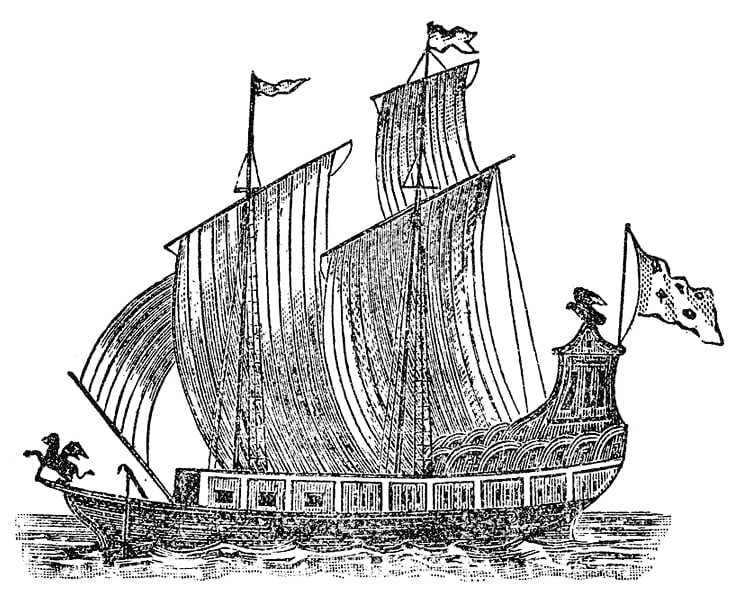Fact or Fiction? 10 Urban Legends in Michigan
Would you like to save this full guide?
Well-known urban legends involving cryptid figures, ghosts, superstitions, and even stories about celebrities invite a whole range of emotions, including intrigue, skepticism, and even fear.
Urban legends in Michigan carry their own curiosity too. From tales of strange lights to frightening creatures to roaming ghosts, the Great Lakes State has a litany of stories to tell. Some have been immortalized in song, some in movies, and others in stories passed down through generations.
While the veracity of some of these tales continues to be debated, there’s no denying that many of them still capture the attention of Michigan residents young and old.

The Dogman
The Dogman, a legendary creature of Michigan folklore, is described as a terrifying hybrid with the body of a man and the head of a dog. First sighted in 1887 by lumberjacks in Wexford County, this bipedal creature is said to have glowing eyes — either blue or amber — and emits a howl that eerily mimics a human scream.
Reports of encounters peak every 10 years on years ending in 7, fueling speculation and fear. The legend was popularized by a song by Northern Michigan disc jockey Steve Cook in 1987. Initially played as an April Fool’s joke, it, rekindled interest in the creature.

The Nain Rouge
The Nain Rouge, or “Red Dwarf,” is a foreboding figure in Detroit’s urban legends, said to be a harbinger of doom. Accounts of its appearance describe everything from a red face, a bright glistening eye, a grinning mouth, fur with an animal body, an old man’s face and rotten teeth.
This malevolent spirit is described as small and fiendish, with origins in Native American legends and Noman French tales of the lutin, who was a hobgoblin-like character. It was even said to bring bad luck to Detroit’s founder Antoine de Manthe Cadillac.
The Nain Rouge’s appearance is said to have proceded major disasters or misfortunes in the city’s history, including before the 1967 Detroit riots and an ice storm in 1976.
The Nain Rouge has become a symbol of the city’s resilience and the annual Marche du Nain Rouge celebrates the defiance of the creature.
The Melon Heads
The legend of the Melon Heads is told in several states, including Michigan, Connecticut, and Ohio. The legend speaks of a group of feral, cannibalistic beings with grotesquely oversized heads, lurking in wait to attack people.
In Michigan, the Melon Heads are said to reside near Saugatuck. One story claims they were ill children who live in an insane asylum. After years of abuse, they were released into the forests surrounding the asylum. Other versions of the story say the children once lived in the mansion and retreated to a cavern system nearby.
The legend has grown across West Michigan and was the subject of a film made in 2011. The Melon Heads are said to attack those who wander too close to their hidden dwellings, adding a chilling caution to Michigan’s backwoods explorers.

Hell’s Bridge
Hell’s Bridge, a rickety metal footbridge over the Rogue River in Algoma Township, is the centerpiece of a chilling legend involving Elias Friske, a deranged 19th-century preacher.
According to the tale, Friske murdered several children, claiming he was purifying their souls. Their bodies were allegedly disposed of in the river near the bridge.
Today, it’s said that the spirits of the children, along with Friske’s malevolent presence, haunt the area. Visitors report eerie sensations such as hearing the children’s screams at night and ghostly apparitions, making Hell’s Bridge a terrifying stop for those intrigued by the paranormal.
The Singing Sands of Bete Grise
The Singing Sands of Bete Grise, located on Michigan’s Keweenaw Peninsula, offer a natural mystery wrapped in legend.
The beach’s sand, under certain conditions, produces a unique, musical sound when walked upon or disturbed. This phenomenon is attributed to the specific size and composition of the sand.
Local lore suggests the sands sing to remember a Native American maiden’s lost love, adding a romantic yet melancholic layer to the scientific curiosity of this natural UP wonder.

Le Griffon Shipwreck
The Bermuda Triangle is a well-known spot in the Atlantic Ocean that’s shrouded in mystery. The Lake Michigan Triangle is a similarly mysterious spot between Ludington, Benton Harbor, and Manitowoc, Wisconsin.
One of the first mysterious events there happened in 1679. The Le Griffon, a massive trade ship set off on its maiden voyage, intending to use the Great Lakes on a journey to the East.
The ship never made it past Lake Michigan and mysteriously disappeared within the confines of the Lake Michigan Triangle. The ship is surrounded by mystery and legend, with its disappearance sparking numerous theories and searches.
Some claim to have seen its ghostly form emerging from the misty waters of Lake Michigan, suggesting that Le Griffon continues to sail the Great Lakes in spectral form, forever lost but never forgotten.

Torch Lake Monster
The Torch Lake Monster legend adds a touch of mystery to the second-largest lake in Michigan. Torch Lake stretches for more than 19 miles and is nearly 300 feet deep; a perfect hiding place for a monster.
Descriptions vary, with some claiming it resembles a classic sea serpent, while others liken it to a giant sturgeon.
A counselor at Camp Hayo-Went-Ha in the 1960s and 70s, Dave Foley, takes credit for the myth, which was later written about in a song. Legend holds that the presence of giant muskie may have contributed to the tale of the Torch Lake Monster.
Sightings are rare and often dismissed as misidentifications or fabrications. Yet, the legend persists, captivating the imaginations of locals and visitors alike, who keep a watchful eye on the waters of Torch Lake in hopes of catching a glimpse of this elusive creature.

Old Presque Isle Lighthouse
The Old Presque Isle Lighthouse, decommissioned in 1871, is the subject of one of Michigan’s most enduring ghost stories.
Built in 1840 on the shore of Lake Huron in Northern Michigan, the lighthouse was active for more than three decades before a turn of events seemingly turned it into a haunted lighthouse.
There are numerous reports of the lighthouse’s light shining brightly at night, attributed to the ghost of a former keeper who refuses to abandon his post. Some visitors also report hearing screams coming from the tower, supposedly from the keeper’s wife who had been locked up there.
Paranormal investigators and curious visitors are drawn to the site, hoping to experience the unexplained phenomenon firsthand and perhaps encounter the lighthouse’s loyal guardian spirit.
Paulding Light
The Paulding Light, observed in a valley near Paulding in the Upper Peninsula is a mysterious light phenomenon that has puzzled observers since the 1960s. The area is surrounded by heavy woods and a stretch of road along Old US-45 ends with a Forestry Service sign.
The legend has become a local attraction, with nightly gatherings of spectators hoping to witness the enigmatic light. The sign explains the light’s presence as being associated with the ghost of a railroad brakeman.
The light appears with no discernible source, varying in color and intensity. Explanations range from paranormal activity to natural atmospheric phenomena like swamp gas to even car headlights, but none have definitively solved the mystery.

True Love’s Kiss
A lesser-known, but enchanting romantic legend involves several Michigan universities with their own version of the story.
At Michigan State University, Beaumont Tower stands above the trees in the middle of campus. The spot itself has historic value, but a couple who kisses in its shadows are said to be true Spartans and are destined to marry.
The Engineering Arch on the University of Michigan campus in Ann Arbor holds a legend that sweethearts who share a kiss under the arch at midnight will be married. It remains a popular spot on campus for photo ops.
The seven-foot-tall seal in front of Warriner Hall at Central Michigan University in Mount Pleasant is also said to be a site for true love’s kiss. Anyone who kisses in front of the seal at the stroke of midnight under a full moon is destined to be together forever.
Embrace One of Michigan’s Urban Legends
From the shores of Lake Superior to the wilds of Wexford County to the lighthouses of Lake Huron, Michigan’s history is tied to plenty of fascinating, if not spooky urban legends.
Whether you believe these legends or dismiss them entirely, the only way for sure is to experience them for yourself. Visit the Old Presque Isle Lighthouse to see if you can catch a glimpse of the keeper. Share true love’s first kiss on campus. Walk the shores of Torch Lake looking for a famous monster. If nothing else, you’ll get to explore more of what people love about Michigan.

